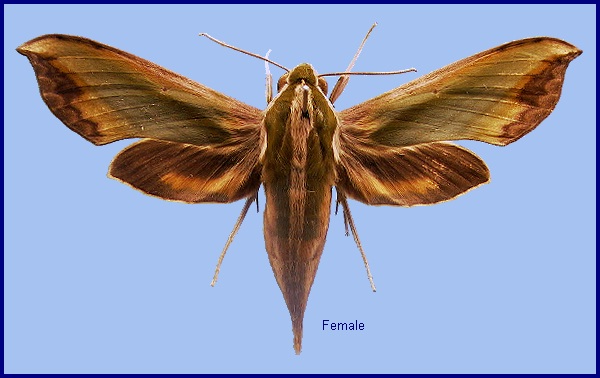
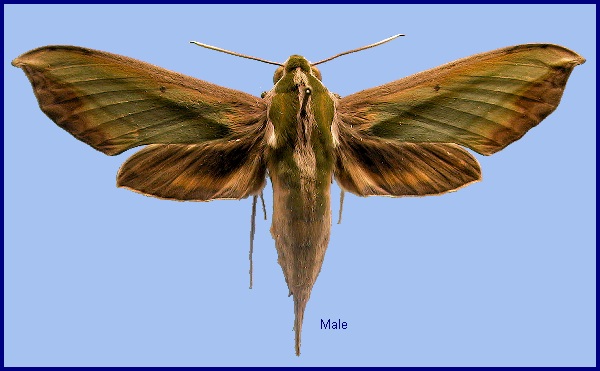
Sphinx acteus Cramer, 1779, Uitlandsche Kapellen (Papillons exot.) 3: 93, pl. 248, fig. A. Type locality: [Indonesia,] northwest Java [Jawa Tengah], Samarang [Semarang].
Synonym. Sphinx acteus Cramer, 1779.
Synonym. Panacra butleri Rothschild, 1894.
Synonym. Rhyncholaba acteus Rothschild & Jordan, 1903.
[Further details on this species in Japan, as well as photos of many stages, can be found on Digital Moths of Japan.]
Wingspan: 64--80mm. An unmistakable species; superficially similar to Theretra nessus but smaller and lacking the long golden subdorsal abdominal patches of that species and with a pale grey dorsal band running longitudinally from the anterior edge of the thorax to the tip of the abdomen. Forewing apex strongly falcate; upperside with a characteristic diffuse green band running obliquely across from the inner margin to the apex; discal spot a minute but conspicuous black dot. Upperside of thorax and abdomen with a conspicuous pale grey longitudinal band.
In the male genitalia, uncus similar gradually narrowed apically, truncate, feebly sinuate, the edge rounded. Gnathos as long as uncus, gradually tapered to a point, apex somewhat upcurved. Valve with more than 12 large stridulatory scales. Harpe elongate, subcylindrical, horizontal, weakly curved, apex concave dorsally, slightly spatulate in dorsal view. Phallus with single dentate process.
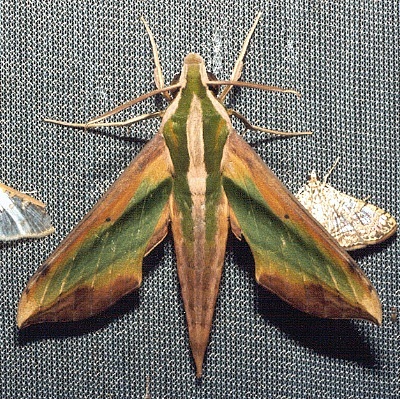
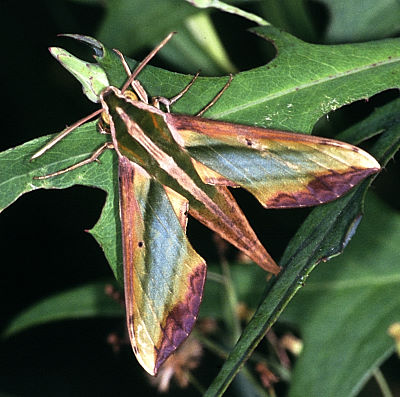
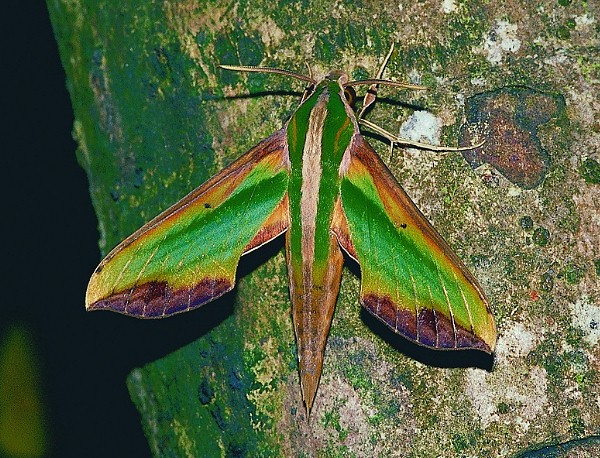
In Metro-Manila, the Philippines, this synanthropic species has been reported as being active at daybreak and during rainy weather, when it has been observed to drink from water puddles next to roads (Dvořák, 2014).
China: iv (Hong Kong); 19-29.vi (Yunnan; Hong Kong; Jiangxi); viii (Guangdong; Hainan; Hong Kong; Guizhou); ix (Shaanxi); x (Sichuan). Taiwan: iv-v (Kaohsiung Hsien); v-viii (Pingtung Hsien). Japan: 15.vi (Kyushu); vi-xi (Ryukyu Archipelago).
OVUM: Bright green, broadly oval, surface smooth and shiny (Bell & Scott, 1937). Laid singly.
LARVA: Full-fed 70mm, width 11mm, horn 3mm. According to Bell & Scott (1937), in the first instar yellow with a straight black horn. In the second instar, head yellow, body bluish-green. There is a dorso-lateral eye-spot on segment 5 which is blue above, black below. Horn long, straight, shiny black with base orange, tip white and translucent. In the third instar, segment 5 tumid, main eye-spot blue with black pupil, the whole edged with black; there are smaller eye-spots on 6 to 11, which are white edged with black. Horn straight, long and tapering, translucent green with base orange, a black ring near tip, tip white. In the fourth instar two colour forms emerge. In the green form the head is yellowish-green; the body pale green, suffused with yellow above the spiracles, dotted with white below them. Eye-spot on 5 large, obliquely oval, the long axis running up and back, pupil black in front shading to deep blue and then mustard-yellow, the yellow obscurely dotted with white; the pupil edged narrowly with white, olive-green and dull yellow. The secondary eye-spots on 6 to 11 are much smaller, obliquely elongate oval, blue edged narrowly with dark green. Horn long, gently up-curved, basal third black with reddish orange base, central third translucent greenish-white, end third black with the tip greenish-white; the orange base smooth, and shiny, rest minutely tuberculate and shiny. In the dark-coloured (brown) form the green is replaced by ochreous chocolate, but with markings the same as in the green form.
In the fifth and final instar, head dull and smooth, small, newly round, slightly higher than broad. True clypeus about one-half length of head, equilaterally triangular; false clypeus with acute apex reaching to two-thirds length of head; labrum one-half as long as clypeus, longitudinally corrugate; ligula kidney-shaped; mandible with cutting edge strongly toothed. Body dull and smooth, of the same shape as those of the genus Theretra, segments 4 and 5 swollen. Horn very short, stout at base, tapering sharply to a point, slightly down-curved, surface shiny, covered with minute tubercles.
In the green form the head is rich grass-green; labrum green, ligula whitish; basal segment of antenna green, other segments honey-yellow; mandible green, tip dark reddish-brown; eyes brown. Body with segments 2 to 5 pale bluish-green, rest of body rich pale grass-green above the dorso-lateral stripe, pale bluish-green with short, dark green or brown longitudinal stripes across the secondary rings below it. There is a very narrow black dorsal stripe from 2 to middle of 5, and a narrow white subdorsal stripe on 3 and 4, which stops at the dorso-lateral eye-spot on 5 near its upper front edge. This main eye-spot is large and oval, its front edge extending on to 4, its long axis is running up and back at an angle of about 45°. Its pupil is deep blue in front, sap-green dotted with white behind, edged narrowly with white, olive brown and ochreous. There is a much smaller, more elongate oval, more obliquely placed eye-spot on 6, the narrow pupil yellow dotted with white and edged narrowly with pale blue, then olive brown and then ochreous. Similar eye-spots occur on segments 7 to 11, their pupils yellow dotted with white, edged narrowly with pale blue, and then with dark blue. A broad bluish-white dorso-lateral stripe runs from the eye-spot on 6 to base of horn. There are similarly coloured broad very oblique lateral stripes on 5 to 11, each starting at the front latero-ventral edge of each segment, running through the spiracle on that segment and stopping at the front edge of the eye-spot on the segment behind; that on 10 running into the dorso-lateral stripe at the eye-spot of 11, and thence running back to base of horn; that on 11 stop at the hind margin of 11, and not running to the base of horn. Horn orange; true legs pale red, prolegs and claspers bluish-green. Spiracles small, oval, white with brown rim.
In the dark-coloured form the green is replaced by rich brown or ochreous-chocolate, the markings as in the green form, the eye-spots a little darker in shade. There is also a red form.
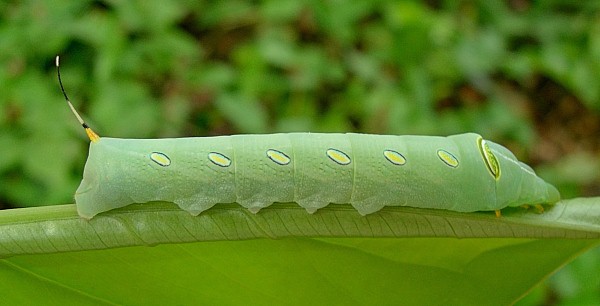
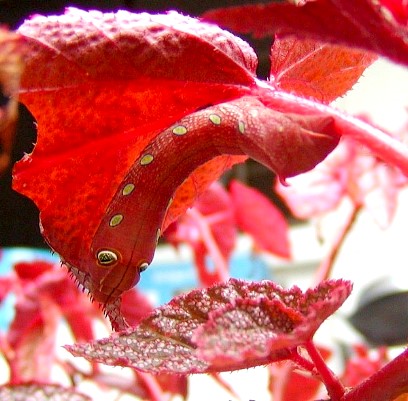
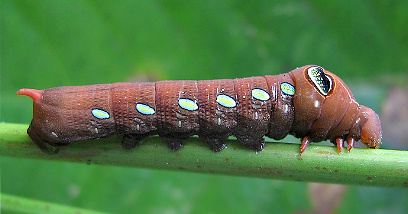
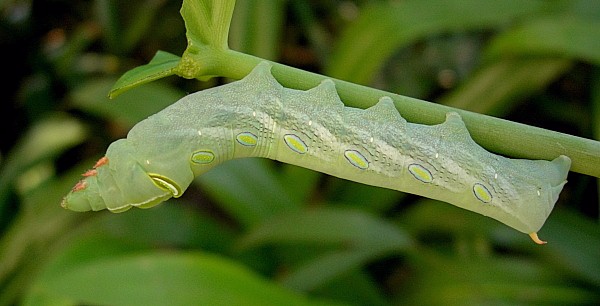
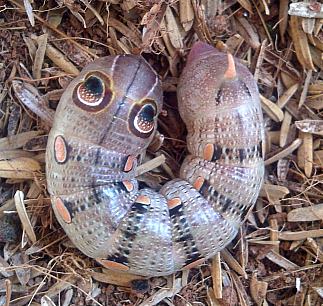
PUPA: 40--50mm, width 10mm, cremaster 3 mm. Colour of head and thorax dull pale yellow suffused with fuscous; the yellow also extending ventrally to tip of wing-case. Tongue-case darker yellow, fuscous at sides; rest of wing-case pale orange; antenna with four lines of black dots; larger brown dots along veins of wings. Abdomen reddish-brown dorsally, with a broad fuscous dorsal stripe; laterally fuscous, with irregular white patches round the spiracles; ventrally pinkish, with broad interrupted ventral and latero-ventral stripes. Spiracles black; cremaster dull orange.
Rather slender in build. Tongue in a free sheath which bends ventrad in a semicircle to which is added the strongly bulbous tip which touches the venter at the junction of the head with segment 2. Antenna shorter than fore leg, which reaches to one-third the distance to tip of wing-case, mid-leg to two-thirds. Surface moderately shiny; tongue-sheath obscurely annulate, with a narrow mesial channel. Head, thorax and abdomen minutely shagreened. Area around the spiracle of 8 finely striate; front bevel of 9 with about twelve small ante-spiracular ridges, fewer on 10. Spiracle of 2 lying in a funnel-shaped hollow, the slit nearly covered by a rounded lobe projecting from the front margin of 3; other spiracles broadly oval, flush, the slit with a narrow rim. Cremaster elongate wedge-shaped, sides nearly parallel in basal half, then curving inwards. Tip widely, shallowly notched, with a small conical tooth at each lateral angle of the notch, and two or three small sharply pointed teeth on each side; sometimes a small median tooth in the notch. Upperside with basal half strongly pitted, distal half longitudinally striate; underside longitudinally striate and with lateral extensor ridges; under the base of the cremaster there is a cup-shaped depression running axially into segment 14.
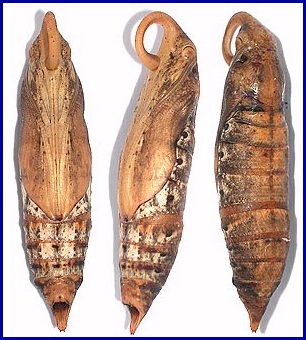
Larval hostplants. Alocasia odora (Araceae) in Hong Kong; Syngonium podophyllum in Bangkok, Thailand; and Amorphophallus konjac in Sichuan, China (He JiBai, pers. comm. 2022). In India on Amorphophallus, Arisaema, Caladium, Colocasia, Dieffenbachia, Begonia, Commelina, Leea, Cissus and Vitis (Bell & Scott, 1937).
On Taiwan recorded from Alocasia macrorrhiza, Alocasia odora, Amorphophallus kiusianus, Ampelopsis brevipedunculata, Ampelopsis cantoniensis, Arisaema ringens, Begonia ravenii, Caladium, Causonis japonica [syn. Cayratia japonica], Colocasia esculenta, Commelina, Dioscorea bulbifera, Leea guineensis, Saurauia tristyla, Tetrastigma formosarum and Typhonium blumei.
In Metro-Manila, the Philippines, larvae are common in the wet season on new growth of woodland edge, roadside, park and garden aroids, such as Alocasia, Colocasia, Caladium and Dieffenbachia (Dvořák, 2014).
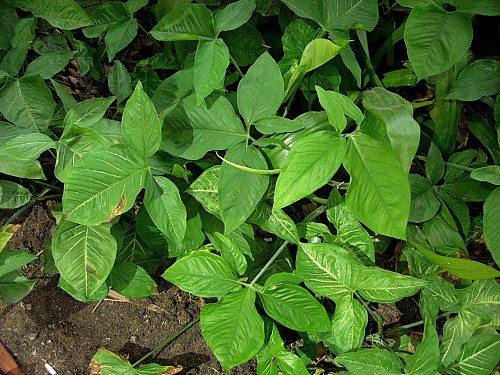
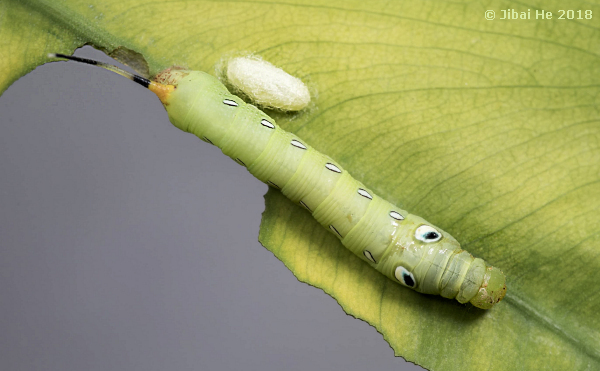
China: Shaanxi (Xunyang, 1380m); Anhui (Mt. Huang Shan); Zhejiang (Tianmushan Scenic Area; Shunxicun); Hubei (Wuhan); Sichuan (Qingchengshan, Dujiangyan National Park; Chengdu; Emei Shan; Longmen; Dong Branch Zi Mountain Villa); Yunnan (Laojun Shan, 2579m; nr. Jinping, 2155m; nr. Lüchun, 1900m; Simao/Pu'er; Gaoligong Shan; Yuxi; Xishuangbanna); south Xizang/Tibet (Mutu, Namjagbarwa region, 1600m (Wang, 1988)); Guizhou (Shiqian; Jiangkou, 700m; Baxicun); Hunan (Hantiancun; Changsha; Chenzhou; Shaoguan); Jiangxi (Le'an; Ganzhou); Fujian (Sanyuan National Forest Park; Sanming); Guangdong (Longtou Shan; ??Wa-Sha-Tai; Wanzishan, Deqing; Nanling National Forest Park; Angang; Wanxiu Rock; Shenzhen; Guangzhou); Macao; Hong Kong; Guangxi (Neidu; Faxian Nongang Ecotourism Centre); Hainan (Chengmai; Haikou; Jiantengling National Forest Park; Wuzhi Shan; Tropical Original Rainforest).
Taiwan: Hualien Hsien (Taroko National Park; Shoufeng; Antung; Hungyeh); Kaohsiung Hsien (Shanping, 640m; Tainan); Taipei (Neihu); Taipei Hsien (Fushan; Wulai); Pingtung Hsien (Kenting; Hengchun; Koshun); Taoyuan Hsien; Taichung Hsien (Taichung City); Taitung Hsien (Yuan Sen Garden; Chihpen); Nantou Hsien; Yunlin Hsien; Yilan Hsien; Orchid Island/Botel Tobago; Chiayi Hsien (Chiayi); Lanyu Island.
Japan: Kyushu (Yuwan); Ryukyu Archipelago (Okinawa, Nago; Tokunoshima; Ishigaki-jima).
Sri Lanka, India (Pathania, Sunita Sharma & Gill, 2014; Chakraborty, Chakraborty, Biswas, Chakraborty & Deb, 2024), Nepal, Sikkim (Khan & Raina, 2017), Bhutan (Irungbam & Irungbam, 2019), Burma/Myanmar, Great Nicobar Island (Singh, Ahmad & Chandra, 2021), Thailand, Vietnam (Le & Vu, 2024), eastern and southern China, Taiwan, Japan (Ryukyu Archipelago), Malaysia (Peninsular), Indonesia (Sumatra, Java, Sulawesi), the Philippines (Palawan).
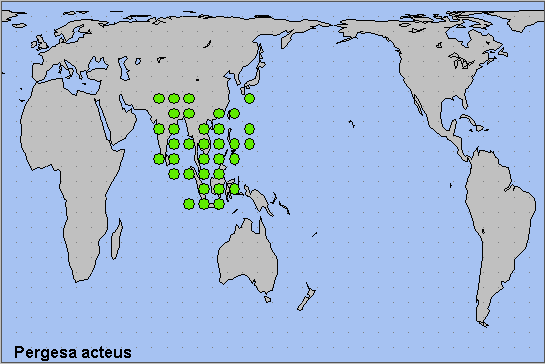
 Return to Sphingidae of the Eastern Palaearctic species list
Return to Sphingidae of the Eastern Palaearctic species list